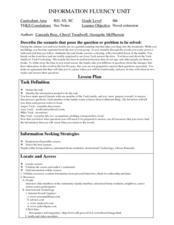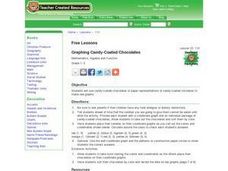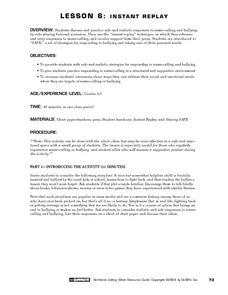Stanford University
Soldiers in the Philippines
Young scholars examine the Philippine War and the treatment of Filipino soldiers.In this Philippine War lesson, studnets analyze documents and inquire as to why there was such brutality. Students use graphic organizers to record their...
Curated OER
Food Webs and Making Miniature Ecosystems
Students model a food web and create a miniature ecosystem. In this animal interactions lesson, students engage in a role playing game which simulates a food web. Students then build miniature ecosystems using pop bottles, snails, plants...
Curated OER
Bodies in Motion
Students work in teams and train in the methods of anthropometry, the measurement of the human body. These activities require calipers or measuring tapes, meter sticks, skin fold calipers, and human skeleton.
Curated OER
Substance Use, or Abuse?
Young scholars identify the medicinal benefits, and ill effects, of a variety of controlled substances. They determine whether or not they think hallucinogens should be researched for possible medicinal purposes.
Curated OER
In the Eyes of the Beholder
Students identify parts of the eye and their functions through participating in a cow's eye dissection lab. They investigate vision problems and diseases, focusing on their causes, and how abnormal vision can be aided with technology.
Curated OER
Comparing Shakespearean Film Adaptations
Though this lesson plan deals specifically with Hamlet and its themes, many of the strategies and approaches here may be used with most any of Shakespeare's plays that have been adapted to film. Viewing clips of the same Shakespeare...
Curated OER
Look At Those Leaves!
Students observe, measure, and sort tree leaves. They examine leaves individually, in groups, and in relationship to the entire tree. They become familiar with the seasonal changing of leaves. They realize that these and other changes...
Curated OER
I Heard It Through the Grapevine
Students write a first-person narrative from the perspective of a runaway slave, or a historical character of the period, and present their story orally.
Curated OER
Poets of Christmas Past
Students consider the meanings of Christmas by reading an op-ed. As a class, they then create a sequel to the poem "A Visit from Saint Nicholas," in which "Mamma" tells a story about the history of Christmas.
Curated OER
Word Processing With Pizazz
Students use a word processor and some of its tools to create an exciting and visual autobiography. They download a sample letter and then create one of their own.
Curated OER
Making an Effective Presentation
Students discover how to effectively deliver a presentation. They use a PowerPoint presentation as the vehicle for looking at guidelines for making an effective presentation. The guidelines apply to any type of presentation students...
Curated OER
Story of Silk
Young scholars investigate the steps of the silk-making process through a reading of the story, "The Empress and the Silkworm" by Toy Hong. Sequencing cards are utilized to enhance the process and a silkworm's cocoon is unravelled.
Curated OER
Novel Extension
Sixth graders play the role of meeting Tuck Everlasting. They prepare to answer that person's questions. They determine that each member of the family wants to know about a different thing.
Curated OER
Irregularly Scheduled Programming
Learners examine their favorite holidays and how they are celebrated. After reading an article, they discuss the length of television programming for the Super Bowl. In groups, they create their own television programming relating to...
Curated OER
What's in a Name?
Students explore how one uses examples from history to inform themselves of past and present events. After reading an article, they examine the significance of renaming a base in Germany after a soldier who survived the Holocaust. They...
Curated OER
Graphing Candy-Coated Chocolates
Learners place pieces of candy on their coordinate graphs as the teacher calls out the colors and coordinates embedded in the plan. The teacher circulates around the class to check each student's answers for accuracy.
Curated OER
INSTANT REPLAY
Students, through role-playing fictional scenarios, brainstorm, discuss and practice safe and realistic responses to name-calling and bullying. They experience the "instant replay" and "SAFE" techniques, in which they rehearse and retry...
Curated OER
It's in the Cards
Students discover how art auctions have become competitive after reading an article from The New York Times. Students voice their opinions about specific examples of modern art and create trading cards based on their research of...
Curated OER
Marine Life, Oceans, Lakes and Rivers
Students examine the types of organisms found in oceans. In groups, they read articles about the research done at certain sites. They work together to research their own water ecosystems and report the findings to the class. To end...
Curated OER
On the Road Again
Students work with patterns to develop formulas that will help them determine total cost. In this patterning lesson, students watch a video about an NBA trainer. (not included) They work in groups to access the assigned Internet websites...
Curated OER
Where Do I Come From?
Students research immigration from Europe to the United States. In this immigration instructional activity, students read the book, The Long Way to a New Land. Students use a world map to locate Sweden and other countries in Europe....
Curated OER
What is It? Susie Sees!
Learners explore the five senses. In this cross curriculum five senses lesson, students view an "I Can See Colors" PowerPoint presentation and sort items by color and shape. Learners mix primary color paints to create secondary colors,...
Nemours KidsHealth
Asthma: Grades 3-5
Young scholars discuss the health effects of asthma. In this asthma instructional activity, learners answer questions about their own history with asthma or difficulty breathing. They create a pamphlet to go in a doctor's office to...
Curated OER
Saudi Arabia -- Future city
Seventh graders summarize an article on Masdar. For this summarizing lesson students clearly explain three of the four points provided in an outline of the article. The students write an essay and identify six physical features of the...

























